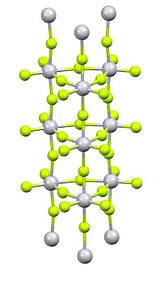Titanium tetrafluoride

| |
| Names | |
|---|---|
| IUPAC name
Titanium(IV) fluoride
| |
| Other names
Titanium tetrafluoride
| |
| Identifiers | |
3D model (JSmol)
|
|
| ChemSpider | |
| ECHA InfoCard | 100.029.106 |
| EC Number |
|
PubChem CID
|
|
| UNII | |
CompTox Dashboard (EPA)
|
|
| |
| |
| Properties | |
| TiF4 | |
| Molar mass | 123.861 g/mol |
| Appearance | white powder hygroscopic |
| Density | 2.798 g/cm3 |
| Melting point | 377 °C (711 °F; 650 K) |
| Boiling point | sublimes |
| Hazards | |
| NFPA 704 (fire diamond) | |
| Related compounds | |
Other anions
|
Titanium(IV) bromide Titanium(IV) chloride Titanium(IV) iodide |
Related compounds
|
Titanium(III) fluoride |
Except where otherwise noted, data are given for materials in their standard state (at 25 °C [77 °F], 100 kPa).
| |
Titanium(IV) fluoride is the inorganic compound with the formula TiF4. It is a white hygroscopic solid. In contrast to the other tetrahalides of titanium, it adopts a polymeric structure.[1] In common with the other tetrahalides, TiF4 is a strong Lewis acid.
Preparation, structure, reactions
The traditional method involves treatment of titanium tetrachloride with excess hydrogen fluoride:
- TiCl4 + 4 HF → TiF4 + 4 HCl
Purification is by sublimation, which involves reversible cracking of the polymeric structure.[2] X-ray crystallography reveals that the Ti centres are octahedral, but conjoined in an unusual columnar structure.[3]
TiF4 forms adducts with many ligands. One example is cis-TiF4(MeCN)2, which is formed by treatment with acetonitrile.[4]
References
- ^ Greenwood, Norman N.; Earnshaw, Alan (1997). Chemistry of the Elements (2nd ed.). Butterworth-Heinemann. ISBN 978-0-08-037941-8.
- ^ Handbook of Preparative Inorganic Chemistry, 2nd Ed. Edited by G. Brauer, Academic Press, 1963, NY. Vol. 1. p. 200.
- ^ Bialowons, H.; Mueller, M.; Mueller, B.G. (1995). "Titantetrafluorid - Eine Überraschend einfache Kolumnarstruktur". Zeitschrift für Anorganische und Allgemeine Chemie. 621: 1227–1231. doi:10.1002/zaac.19956210720.
- ^ Nikiforov, Grigory B.; Roesky, Herbert W.; Koley, Debasis (2014). "A survey of titanium fluoride complexes, their preparation, reactivity, and applications". Coordination Chemistry Reviews. 258–259: 16–57. doi:10.1016/j.ccr.2013.09.002.

